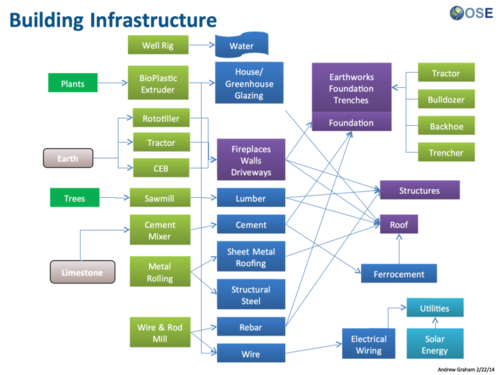CEB Press Design Rationale, Product Ecology
Design Rationale
Animation Credits: Alexander Lieders .
The design objective for the OSE CEB was to produce the simplest, high performance, lifetime design, design-for-disassembly machine - made with stock and minimum-machined parts - at the lowest possible cost. The design follows OSE Specifications
The OSE CEB press is a vertical press, where soil falls by gravity directly from the hopper into the compression chamber. The main cylinder compresses soil, and the soil loading drawer closes/opens the compression chamber and ejects bricks from the machine. (Controller Design, Hydraulic Design)
Results and Improvements Made
- See machine specifications from 2010.
- Note on the brick pressing rate: maximum of 16 thin bricks per minute with 54 hp, without using grate shaker
- The main addition to the CEB machine design since last year is the increase of machine height from an 8" to a 12" main pressing cylinder, so that the resulting bricks are (2"-6")x6"x12" as opposed to the (2"-4") bricks.
- This means the pressing rate is reduced but larger bricks are made
- Because it was late in the season and the soil was typically too wet, we had bridging problems and we could run the machine only at half its rated power, or 27 hp
- Brick pressing rate was 4 bricks per minute with 27 hp for full-size (6"x6"x12") bricks
- The compression chamber front and back u-channel was reinforced with a 1/2"x2" bar along its length to prevent it from bulging out; this failure was not observed in Prototype I and II because the width of the main chamber was 4" and 3" smaller
Improvements Needed
- The machine is currently moved into place by forks, but a trailer will be added to improve mobility.
- Sides will be added to the grate to prevent soil from falling off the grate
- Flat bar will be used instead of rebar as the grate to facilitate soil falling through the grate.
Product Ecology

| From | Uses | Creates | Enables |
|---|---|---|---|
|
Components |
Physics of why the CEB press works
Bricks are made of 20%-30% clay, the rest being sand and silt. A combination of mechanical and electrostatic forces is responsible for the high strength of compressed earth blocks.
Compression physically removes voids from the earth. As particles come closer, mechanical forces of rough particles touching each other lock particles into place. For microscopic particles of clay, which are less than 4 microns in size - electrostatic forces of intermolecular attraction begin to play a role.
For stabilized bricks, chemical binding forces of the binder - such as cement - are responsible for the strength. Cement binders tend to bind larger particles of sand and aggregate, and lime binders tend to bind the finer particles of clay.
It appears that the exact nature of the large compressive strength of pressed earth is not well understood.
Back to Table of Contents






